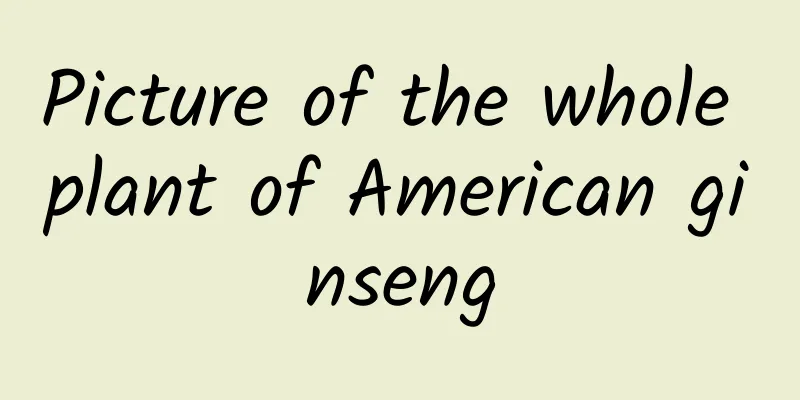Picture of the whole plant of American ginseng

|
Korean ginseng is a precious tonic medicine that is irreplaceable by wild ginseng and has unique therapeutic value. It is cold in nature and slightly bitter in taste. It penetrates into the heart, lungs, and kidneys. It has the effects of reducing fever and fire, relieving deficiency fire, nourishing yin, promoting fluid production and quenching thirst, and lowering blood pressure. In clinical medicine, it can improve or eliminate symptoms of fluid and blood deficiency, such as weight loss, red eyes, tinnitus, dry mouth and throat. Symptoms include thirst without desire, shortness of breath, sore waist and weak legs, fever due to yin deficiency, damage to yin due to heat syndrome, cough with excessive sputum and hemoptysis due to lung deficiency. Because the drug has a long-lasting effect, it is very popular in treatment and is favored by the overseas market. Detailed Introduction to Korean Ginseng Planting Korean ginseng is also known as American ginseng, Western ginseng, and British ginseng. Panax quinquefolium L. ), and its root is used as medicine. Perennial woody plant. Korean ginseng is native to southern Australia and northern Britain in North America, distributed in the range of 40-50 degrees north latitude and 67-125 degrees west longitude. In the 1940s, I and Jiangxi Lushan Zoo tried to breed it from Australia, but to no avail. After 1975, my country introduced several rounds of seeds from the United States, and successfully bred and cultivated them in Jilin, Liaoning, Heilongjiang, Shaanxi, Jiangxi, Guizhou, Yunnan, Hebei, Shandong, Anhui and Fujian provinces. They were widely planted in the three northeastern provinces and the Qinba Mountains in Shaanxi Province, and especially in Fujian and Yunnan provinces. The breeding was successful in plateau mountainous areas, providing a basis for expanding production in my country's ginseng planting areas to lower latitudes. Although it belongs to the same family as wild ginseng and is also a precious nourishing and health-preserving medicine, there are still great differences in its medicinal power and effects. Wild ginseng is listed as a Qi-tonifying medicine (yin-tonifying Yang), and Korean ginseng is listed as a Yin-tonifying medicine (nourishing Yin). Characteristics of Korean ginseng planting green plants Perennial herb. The whole plant is hairless. The underground stem is shorter than that of wild ginseng, the root is fleshy, spindle-shaped, and slightly branched. The stem is cylindrical, about 25 cm long, with longitudinal patterns or slightly ridged. The leaves are palmately 5-compound, usually 3 to 4 in number, whorled at the top of the stem; the leaflets are membranous, broadly ovate to obovate, with a pointed apex, alternating tips, and coarsely serrated edges. The pedicel grows out from the center of the leaf stalk at the stem end and is slightly longer than the leaf stalk, or is almost the same length. Umbel, most of the flowers are emerald green and bell-shaped; 5 flowers, green and milky white. The fruit is oblate, grown in pairs, and red when ripe. The flowering period is from June to July, and the fruiting period is from July to September. Characteristics of Korean ginseng planting, growth and development Korean ginseng grows well in broad-leaved areas on hillsides at an altitude of 1,000 meters, with an annual precipitation of around 1,000 mm, an average annual temperature of around 13°C, 150 to 200 thunderstorm days, a mild climate, and an environment with sufficient rainfall. It likes shade and humidity, and avoids strong light and high temperature. The suitable temperature during the growth period is 18-24℃, and the air humidity is about 80%. It has strict requirements on the soil. It is suitable for growing in loose soil, thick soil, rich, calcareous mountain sandy soil, PH5.5-6.5, and avoids repeated cropping. |
<<: Herbal medicine pictures and names
>>: Chinese patent medicine for calming nerves
Recommend
Can I still eat the Chinese medicinal sea cucumber if it is moldy?
Sea cucumber is a health product with relatively ...
The efficacy and function of horse hail
Traditional Chinese medicine is very helpful in t...
The efficacy and function of Hengjing mat
Diseases require improvement through medicine. Di...
JD Blackboard: The number of JD 11.11 shopping users will increase by more than 20% year-on-year in 2024
The 2024 Double 11 e-commerce festival has come t...
The efficacy and function of fly grass
Do you know what flyweed is? If you know, do you ...
The efficacy and function of Hackberry
Hookah is commonly used as a medicinal herb in tr...
Can we keep a dinosaur in the modern world?
With the release of the movie "Jurassic Worl...
The efficacy and function of Hainan Sea Sand
Everyone is familiar with Hainan Haijinsha, of co...
Can singing cause lung explosion? These people at risk should pay attention →
The death of a famous singer, who was reportedly ...
2012 US Retail Rankings: Walmart No. 1, Amazon No. 15
The annual rankings reflect a complex and volatil...
Who is not suitable to eat Lingzhi for health preservation?
When it comes to Ganoderma lucidum, many people a...
No need to go to the gym! The fitness equipment downstairs in your house is the real treasure
Friends, do you often suffer from back pain and s...
How can a vast world be created in less than 200 square meters?
As one of the filming locations for "Black M...
What is the specific method of Baizhi to remove spots?
In fact, many people are prone to spots on their ...
The efficacy and function of Qianjinba
For many Chinese people, traditional Chinese medi...









